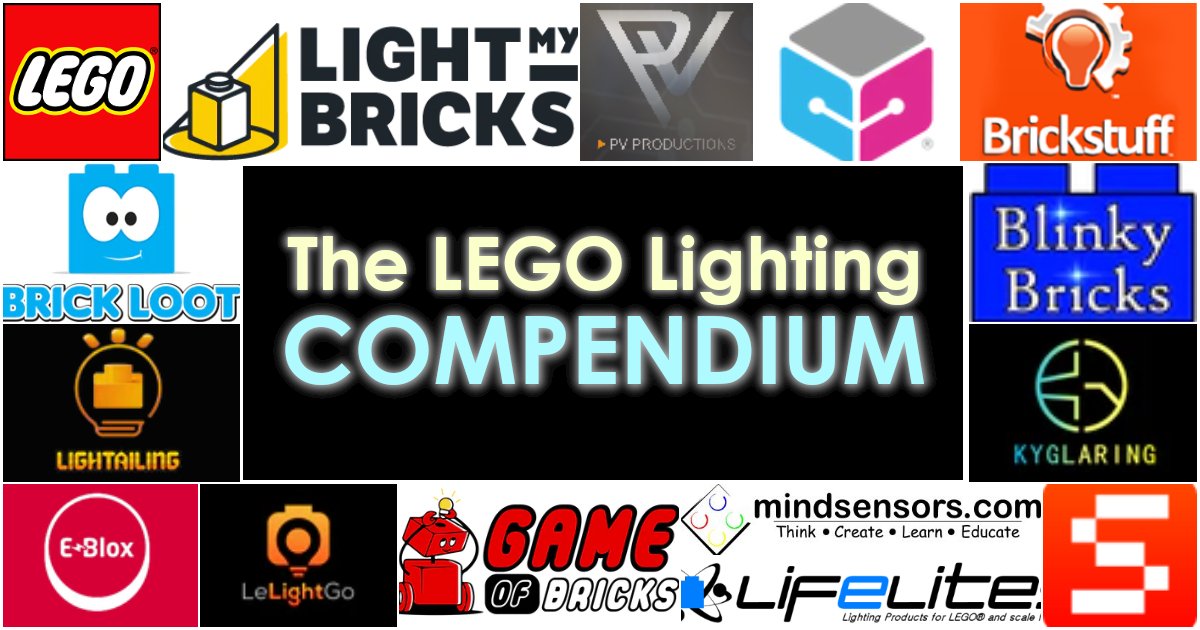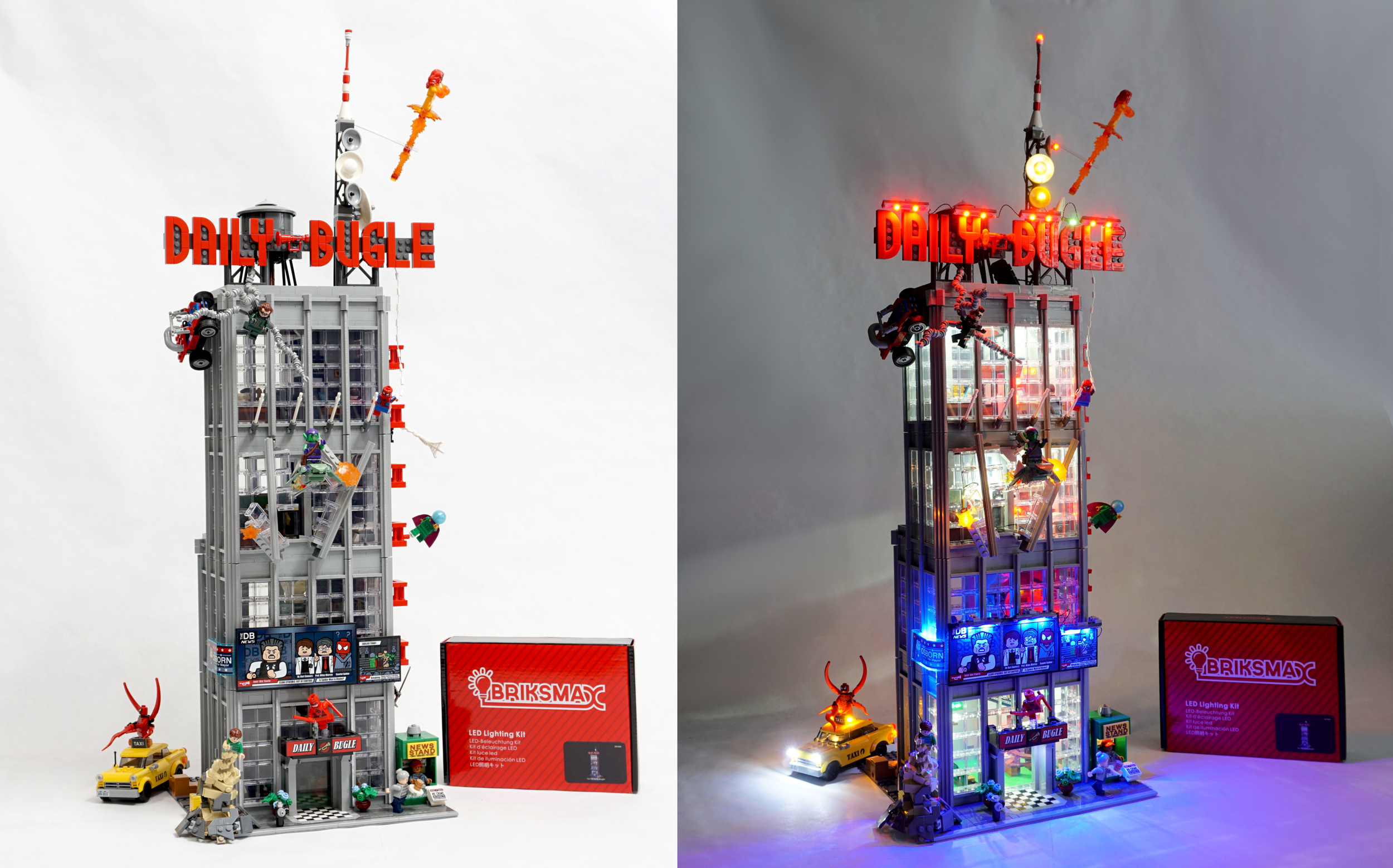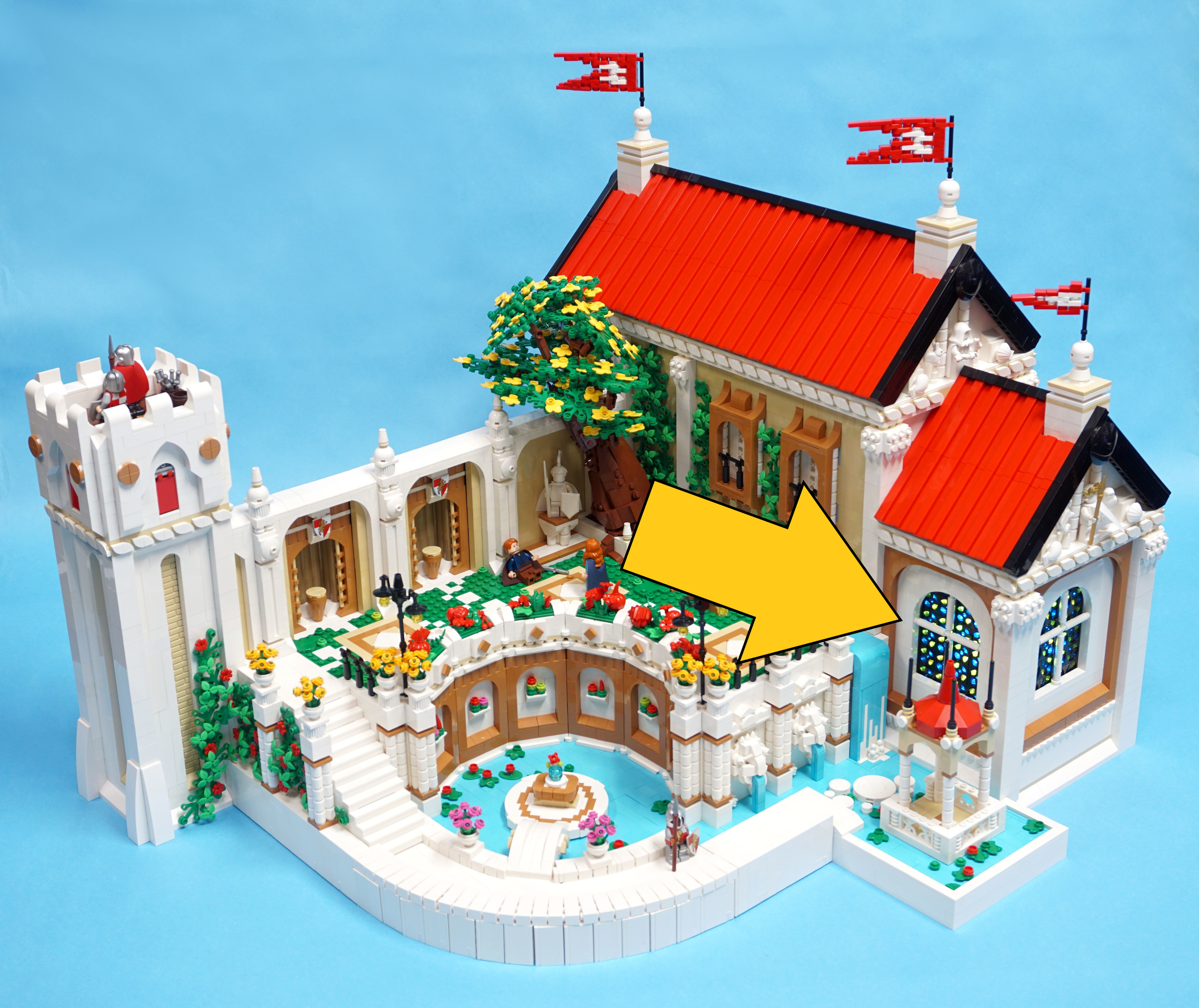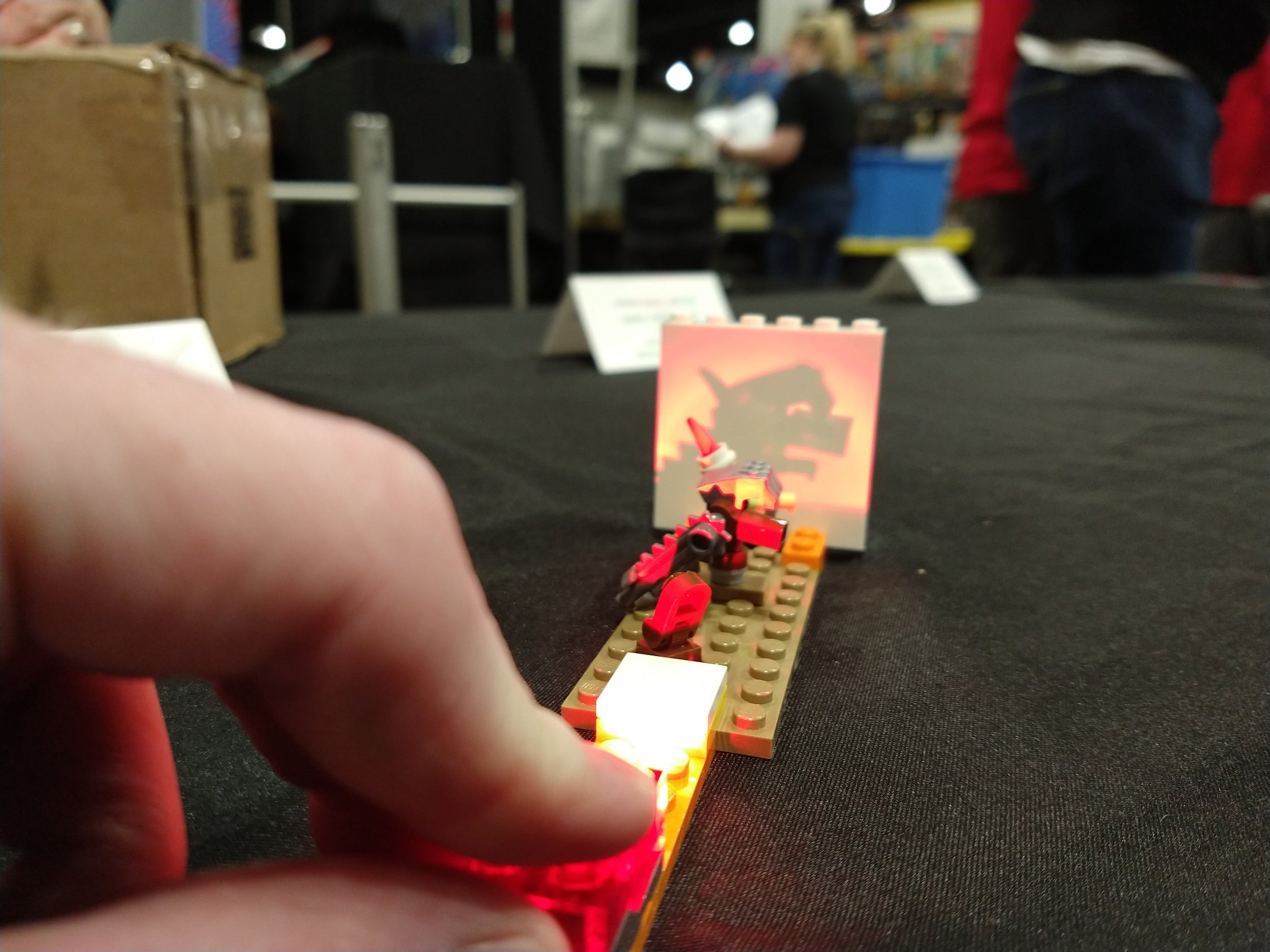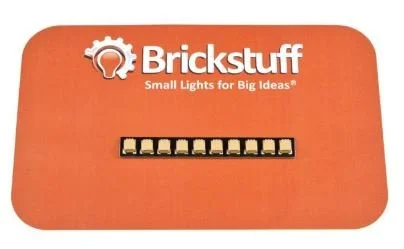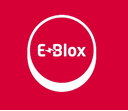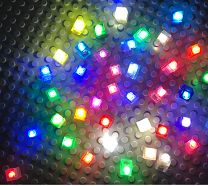The LEGO Lighting Compendium: Join the Light Side!
/Best of BrickNerd - Article originally published July 28, 2022.
So lights are cool, right? Everything looks more awesome when you add lights to it: Houses, cars, PCs (you have no idea how much RGB madness is pumping out of the thinky box on my table)… and especially LEGO.
In the past here at BrickNerd, Are talked about why one would want to add lights to an existing MOC, and Rob from Brickstuff gave a fantastic tour of his company’s history and offerings. We’ve also had Ann delve into how you can use existing lights on hand for spectacular results in MOC photography. But in my admittedly lackluster research effort, I have yet to see a good overview of what all the options are for LEGO lighting.
So that’s what we’ll do here: This article will delve into your options, what you might want to use lighting for, what types of products are out there, and where to get them.
Before we get into the nerdy nitty-gritty, I quickly wanted to talk about the inspiration behind this article – a disclaimer of sorts: The nice folks at Lightailing/Briksmax contacted us at BrickNerd asking if we’d write a review. Since we generally don’t really do traditional reviews, I suggested including them in a more BrickNerdy article with a comprehensive look at the world of LEGO lighting. (Many thanks to Eva from Lightailing for your support with this article.)
As I mentioned, I’ll be splitting this article into three sections:
Use Cases: why would I want to mix photons with my ABS?
The Goods: what products are out there for me to spend my hard-earned cash money on?
Where to Shop: I’ll give an overview of all the purveyors of fine LEGO lighting products.
So follow the light, and let’s begin!
Lighting Use Cases
Light can do so many things – way more than you might consider at first. Here are various use cases, covering anything and everything from display purposes to photographing MOCs.
Displaying Sets
A very popular reason to add lights to LEGO is for those who display sets prominently and want to add that extra little special something to the display. Lights built into sets can make them pop like you wouldn’t believe! See here how I used a Briksmax kit to light up the Spiderman Daily Bugle set.
Adding lights to sets is a great way to add some oomph to your display!
On its own, the Daily Bugle is quite a statement piece, but I think the lights add a dynamic nature to it that brings it more to life, and I think I’ll pop this on quite frequently when hanging out in my LEGO lair! (In all transparency, I may have mangled a wire messing with the connectors on the second floor causing it to not light up… whoops!)
MOC Photography
Personally, the most relevant reason to pair light with LEGO is to add them to MOCs. This is something I do on a frequent basis for one reason or another, all of which I’ll get into below. To determine what lights you need for your MOC, you have to think about what color(s) you want to use, if the lighting needs to be dynamic (blinking, etc.), how many lights you need, what kind of space you have for the power supply if it needs to be hidden, and what other requirements your particular build levies on the lighting products.
The main MOC lighting purpose for me is for photography. You might want your vehicle to have lights that are actually lit up, or perhaps you want to lighten up an interior room so it’s visible in a picture, or maybe you want the MOC to have a mood to it, or maybe you just want to add another dimension to the build. Lighting can be used to create an effect in the image that you just can’t achieve in post-production without the right lights to start off the process – or at least I can’t! Some people can perform magic in post-production, but even so, there’s only so much you can do without the right lighting.
Both the photo above and the one below are examples of where I used lighting to create a specific mood:
I love builds that use a very limited light palette to achieve something moody or spell out something specific story-wise. But there are many other uses in MOCs.
Enhancing MOCs
I also use lighting for adding just that extra touch to some MOCs, for instance in my Wheel of Time “The Daughter Heir” build, I added a grid of power function lights behind the stained glass to get it to really shine! If I hadn’t done that, the windows would have felt a lot more lifeless.
Remote control vehicles are another interesting use case, where people will build in lighting effects to get the most out of their mobile creations. I’ve seen interior lights, headlights, tail lights, undercarriage lights, lights used for various decorative effects, and probably more.
Displaying MOCs
Another great use case is for displaying custom creations. And one of my favorite specific display examples is seeing MOCs lit up at cons. I got to see some amazing examples of this at Brickworld Chicago 2022 this year during their “World of Lights” event.
It was incredible walking around the show and viewing so many displays that used the light in creative and effective ways. You certainly see a lot more dynamic lighting effects for display models as that gives an extra dynamic element to catch the eye.
Here’s the wonderful display from our Bricknerd in chief Dave Schefcik!
Often when lights are added for a display, they are used to make the MOC shine at night, either to be more realistic looking or simply to get a neat feel. And I especially like it when the lights have effects like blinking or flickering or flashing (like Are’s example with the cameras). This won’t come across in your static Flickr photo, but it sure livens up the MOC for viewing in person!
Now I mentioned it in passing before but it deserves a full mention—Are brought up the idea that you can revisit a MOC later by adding lights, and I love that! I think a lot of MOCs can get some extra longevity and a fresh feel to keep around on display if you add lights.
Lighting as an Artform
It’s even more interesting when a MOC uses light… to become the MOC. Wrap your head around that inception-y business while checking out this mind-blowing example of a MOC that’s all about the light:
All about the light? Maybe more like all about the shadow!
Super talented builder Amanda Feuk is known for her intricate creations that use shadow to paint an image, and she won the coveted Brickworld Master title in 2019. So in the time-honored tradition of such mastery masters, at the next Brickworld (which happened to be 2022), she left these brilliant little shadow builds with numerous MOCs to show her appreciation.
So that concludes my tour of typical use cases… though I bet you creative readers are ripping your hair out and pounding your fists at the table with your annoyance at how many other uses I missed. I’m here to learn, fellow nerds, so shoot us a note in the comments if you have other applications!
The last thing I’ll say before moving to our next segment of the tour is that you should first trust your gut and always try out that zany lighting idea you have. Don’t let the “typical” solutions below hamper you in any way or cause you to think that you have to spend a lot of money to achieve these effects. A very patient person can use a single light to light up a large MOC in many diverse ways by simply taking a lot of pictures from the exact same angle while moving the light around and combining the images in a photo editing program like GIMP. Maybe buying lots of lights makes your life a little easier, but if you’re saving your cash for that next big Bricklink order then don’t sweat it! Plus keep in mind that unless you break ‘em, lights can be reused infinite times in infinite ways.
The Lighting Goods
Now we might know what we want to achieve with lights, but what are the options? What’s out there? Do you see tables and racks full of products at cons but it’s all just a bit overwhelming? Then this list is for you! There’s a wide world of lighting options out there, so let’s break it down:
Kits
The first class of products I’ll cover are kits. These are typically a pre-designed and packaged set of lights and a battery pack to run them which are designed to be used with a specific set (like the Daily Bugle example above). These tend to come in three varieties:
Set-based kits with bundled lights that are built into bricks and strung together. These are custom-made to fit perfectly into a particular set and are as easy to install as you can get. The reusability is a bit hampered by that prescribed nature, but creative types can reuse them.
Set-based kits with individual parts that are assembled into the set with a little elbow grease. These are a lot more parts, but think about the reuse! You now have your very own set of components to do with what you please in the future.
Starter kits which sometimes are meant for a specific set, but at least ensure you have a decent little pile of parts to reuse later.
Here’s a kit with bundled lights
Individual Components
OK, this is the big kahuna if you will: individual components cover the gamut of everything you could have imagined—and possibly more. You can achieve any effect with a combination of the following options. Before diving into the list though, I’ll pause to discuss some key form factors and interconnectivity points.
The lights below may not always fit together with the listed power sources. Some have standard LEGO power connections while the vast majority of the others have tiny connectors first implemented by pioneers such as Brickstuff. These have become a sort of third-party standard while others may have proprietary connections. (Brickstuff has also created adapters so products from different companies can work together.)
Considering the wiring, LEGO products that are lit tend to require thick and robust wiring that has to be accommodated by quite large gaps in your MOC. The longevity of such robust products certainly is a fair trade, but the alternatives made by so many of the third-party manufacturers are great options as well. These third-party products are almost always built around tiny micro connectors and extremely thin wires. You can usually cram the connector through a 3 mm hole, and the wires can squeeze between almost any bricks provided you’re ok with a slight gap in your creation. You’ll have to weigh the flexibility that provides against the frailty inherent in such teeny components.
Look at those cables sneaking right between adjacent bricks!!
If you were looking for lighting components, you have come to the right place. Here’s a list of everything you might need for your lighting endeavors. You’ll note that the list starts with lights, but we’re also covering other categories of essential ancillary equipment.
Lights
One or more LEDs in various formats, sizes and wire lengths. When you know what you want your build to look like, you start ticking through these options to decide which will work best:
LED point lights—tiny LEDs a bit bigger than 3 mm
Single color (many color options)
Blinking
RGB—with the right equipment from further below you can often choose from many colors in the spectrum
Rugged cables and bulbs (LEGO brand)—also a bigger form factor than the other brands
LED strip lights (from short inch-long strips to multiple feet in length)
Single color (many color options)
RBG (many color options)
LED flood lights—consider these as flood lights for a LEGO building
Single color (many color options)
RGB (many color options)
Light strings (wires available in numerous lengths)
Single color (limited color options)
Multi-color (similar to Christmas-themed light strings)
single color (limited color options)
UV light strip (for that blacklight effect)
Sets of multiple lights on a single connector (see image at the end of this article with a segment of a small USB-connected light string with different colors built-in)
Customized LEGO elements that were modified to add a light element
Lightsabers, lamps, lampposts and more!
Power Components
Something has to make the lights light up… There’s a surprising amount of options for how to get electrons into those teeny wires.
Battery packs
Mindstorms RCX / NXT / EV3 / Boost / Spike Prime hubs
Power banks with custom connectors
Socket-based solutions (i.e. options you plug into the wall)
Various others can plug into the wall for sustained continuous power
Connecting options
Extension/connector cables of varying lengths
Expander boards/splitters (rows of connectors that enable using a single power cable to power any number of lights connected to the board)
Converters that enable plugging different types of cable connectors together
USB to mini connector
Wireless power connections
No-touch wireless options (there may not be any in production at the moment)
Switches
USB hubs to distribute power to multiple USB connections
Controllers
Do you want the lights to do something other than just being “on” with the power switch? Check these options out:
Wireless remotes that connect to lighting effect controller boards & RGB boards (sometimes packaged with lighting systems)
Effects boards that perform the same function continuously while powered
Flashing, flickering, and multifunction (typically has an onboard switch to change modes)
Cell phones—that can connect with LEGO Technic Hubs
Mindstorms RCX / NXT / EV3 / Boost / Spike Prime Hubs
Music/Sound Effect Components
Want to play around with some sound options? There’s some neat stuff for that.
Receiver board for music control
Music remote
Memory card
Speaker
Old school LEGO sound bricks
Lighting Products not Marketed for LEGO
It turns out there are about a bajillion light options in the world if you take the search term LEGO out of your Googling. There’s just so much to get into that I know I’ll miss most of it… but I’ll list a few just to give you an idea.
Regular lamps placed strategically
Different “temperature” (white tone) bulbs
Colored bulbs
RGB remote or cell phone-controlled bulbs/light strips/light strings
And more! Use what you have on hand, you’ll be amazed at what you can accomplish!
Digital Light
Yes, even renders can start to incorporate light now with programs specifically to emulate a light source within your digital creation.
BrickLink Studio can make any brick “light emitting” in renders
Blender can be used for dynamic lighting of renders
Here I used two light bricks from a creator set during a contest at a con!
Where to Start
[Some Readers]: Uh wow, that’s a lot of stuff… what would be the absolute minimum I could buy or acquire to start playing with lights?
[Me]: I’d say the easiest way in is if you happen to have a LEGO light brick. These 2x3 sized bricks are easy to build into a MOC if you’re planning ahead and give you a simple spring-loaded push switch to turn it on. They come in a number of sets so chances are you have one already.
If not that… the absolute simplest is basically a power supply plus a single light or light string. Here’s an example:
See, it doesn’t take much to get started!
Where to Shop?
There are a lot of options for purchasing lighting for LEGO, so there should be something for everyone. We might have missed some, and if we did, please tell us in the comments so we can amend this resource in the future. We start with a little overview on each company, some of which aren’t even really focused on lighting.
LEGO and LEGO Connector Compatible
First up we’ll tour through the LEGO and compatible with LEGO brand power connection equipment sellers. The options are limited here but at least it’s all compatible with other LEGO gear you may have on hand. Links to each are on the images.
LEGO - Denmark (1932)
Let’s play well! The original, the great, the source of our obsessive hobby.
Products: basic white LEDs, large format, durable, medium brightness. Other dabbling like light bricks, train lights, and a few older options.
Fx Bricks - Canada (2016)
One-stop shop for lighting, sound and action, all in one easy-to-use and highly engineered system.
Products: Control bricks, cables, boards, speakers, powered train track, and more.
Mindsensors - USA (2002)
STEM focused.
Products: Mindstorms-related - LED light strip and compatible mindstorms connectors.
PV Productions - Netherlands (2011)
GBC focused company.
Products: light string and UV LED strip, PF and PU compatible.
Third-Party Kits and Components
These are the majority of companies making a lot of similar (often compatible) third-party parts and the kits to make your sets shine. Generally, if you’re looking for third-party lights in a small flexible format including all sorts of color and RGB and function options, these companies should have you covered. Alphabetical order, of course.
Blinky Bricks - USA
Good variety of lighting products- all for DIY projects, no pre-made set-based kits.
Brick Loot - USA (2013)
Unique in providing a subscription box service as well as lighting products.
Products: Variety of products incl. lighting.
Brickstuff - USA
OG of lighting products, developed many of the components first, and one of the more LEGO-community-focused companies.
Products: set-based kits, custom parts of all sorts, will take on custom jobs of all kinds, and releases new and unique products frequently.
Game of Bricks - Estonia (5+ years)
Products: set kits and custom parts.
Kyglaring - China (5+ years)
Products: set kits and custom parts.
LeLightGo
Products: set kits and custom parts.
Lifelites - USA
Products: Various lines of lighting products, custom work, other non lighting items.
Lightailing - China - Lightailing (2017) Briksmax (2019, for custom parts)
The inspiration behind this article, thanks!
Products: huge selection of set lighting kits and custom lighting parts.
Light My Bricks - Australia (2015)
Also has warehouses in the US and The Netherlands.
Products: huge selection of set kits and custom parts.
Unique Lighting Options
These companies decided to break the mold and produce some unique options!
Circuit Cubes - USA (2015)
STEM focused.
Products: STEM kits and custom parts based on a cube-like format (4x4 studs).
SBrick - Hungary (2013)
RC vehicle-focused company, famous for the SBrick Bluetooth controller. Light elements need an SBrick to be on and active and the phone app needs to be open to stay powered.
Products: power, Bluetooth controller brick, vehicle lights products.
Brick Lighting Specialty
Nothing but glowing bricks here!
E-blox - USA (2016)
Products: custom bricks with built in lights that conduct the electricity to each other.
i-Brix - USA
Kickstarter that never made it to regular production.
Products: wireless powered light bricks.
Laser Pegs - USA (2018)
A subset of “Never Wrong Toys and Games”
Products: known for light up battery powered bricks sold in kits with trans bricks.
Resellers With Some of Their Own Products
These stores sell lighting products made by some of the fine manufacturers above, plus some neat unique options of their own!
The Brick Show Shop - USA
Products: vendor for lots of other brands (lots of custom little sets) with some of their own products like jewelry, lights, etc.
Elegant Bricks - UK (2018)
Products: reseller of Light My Bricks kits and light components and also sells a few custom parts including a unique item: departure boards for train stations.
The Light at the End of the Tunnel
You made it to the end, and there was light after all! Well done and congratulations on passing our crash course in LEGO lighting options. We knew you could do it! What’s next, you might ask? My advice is to let these things come naturally. Come by your MOC ideas as you usually do, but next time you have an idea, before you actually get started, I want you to pause for a second to think if there’s a lighting option that would add to the awesomeness of your build.
You’re of course always feel free to share your inspiration with us here below in the comments section, or even ask questions about lighting, and we’d love to help! Let’s fight the Sith together by joining the side of the light!
Did we inspire you to consider ligthing for your next MOC? Or did you spot a cool creation using light at a recent show? Share your thoughts in the comment section below!
Do you want to help BrickNerd continue publishing articles like this one? Become a top patron like Charlie Stephens, Marc & Liz Puleo, Paige Mueller, Rob Klingberg from Brickstuff, John & Joshua Hanlon from Beyond the Brick, Megan Lum, Andy Price, John A., Lukas Kurth from StoneWars, Wayne Tyler, LeAnna Taylor, and Monica Innis to show your support, get early access, exclusive swag and more.

